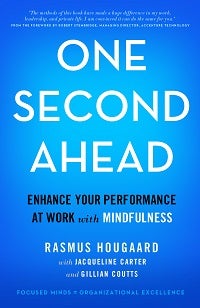 What if you could press “pause” on your day at any moment? In One Second Ahead: Enhance Your Performance at Work with Mindfulness, Rasmus Hougaard, Jacqueline Carter and Gillian Coutts say you can. They argue that the best way to address the constant distractions that come our way is to take one second to be mindful and to make good choices that help us to remain focused and calm.
What if you could press “pause” on your day at any moment? In One Second Ahead: Enhance Your Performance at Work with Mindfulness, Rasmus Hougaard, Jacqueline Carter and Gillian Coutts say you can. They argue that the best way to address the constant distractions that come our way is to take one second to be mindful and to make good choices that help us to remain focused and calm.
In the following excerpt from the book, Hougaard provides five guidelines for being more mindful when using email.
Regardless of your job, your location, or your industry, email probably takes up a significant portion of your time at work — while not always producing the best results. In this technique, I offer five simple ways mindfulness can make you more efficient and effective at using email, as well as other electronic forms of communication like texting, office messaging systems and the like.
Guideline #1: Avoid Email Addiction
How often do you check your email? A few times a day? Hourly? Every time that gadget in your pocket buzzes or lights up? Can you honestly go without checking your email for any significant stretch of time?
If not, you’re not alone. One report shows 60% of Americans check their email on vacation and 25% become restless and unwell after just three days without access to email. In fact, doctors have estimated 11 million Americans suffer from “email addiction.”
If you think this sounds crazy, think again.
Email dependency is principally the same as any other type of dependency. When you receive a grateful message from a client, praise from your boss, an interesting article or a funny joke, your brain releases dopamine — a neurotransmitter released in the brain that makes you feel good. Craving that lift from a nice or funny email creates a tendency to check your email more and more often.
Mindfulness training puts you better in tune with your thoughts, feelings and cravings. When you get the urge to check your email for its own sake, observe it. Before you automatically succumb to that urge, pause. Take just one second. And in that second, you’ll come to see there’s nothing necessarily automatic about your responses to stimuli. You have a choice.
Sometimes, one second of mindful contemplation is all it takes to resist an automatic impulse. There are a number of things you can do to increase your chances of success in mitigating or avoiding email addiction. The first is to eliminate all notifications.
Guideline #2: Kill All Notifications
Having your email always on, even if only in the background, can create a lot of unnecessary “noise” both in the lives of individuals and within functioning organizations. One of the simplest ways to create more time and improve mental focus is to eliminate unnecessary noise. When it comes to email, you can do yourself a favor by switching off your email notifications, pop-up windows, alarms, and ring tones. Doing so will keep your time between designated email sessions clear for other, more important work.
Over the next couple of days, pay attention to what happens to your focus, your productivity, and your well-being each time you’re distracted by an email notification. Then try working for a couple days with the notifications switched off. After that, you can make an informed decision about what works best for you.
“When you get the urge to check your email for its own sake, observe it. Before you automatically succumb to that urge, pause. Take just one second.”
A lot of the time, getting a new email pulls our focus away from the job at hand, forcing us to shift from task to task. The next guideline for mindful emailing is to stop that shifting before it starts.
Guideline #3: Mind Your Switch Time
Addicted or not, many people leave their email open all day long. It helps them feel like they’re perpetually productive and constantly up to date. Always online, they often answer emails shortly after receiving them. That might be helpful if someone needs an immediate response, but it can also cause its own problems.
If you allow your focus to shift every time a new email arrives, you’re wasting time. It takes your brain several seconds to concentrate on a new email, and then the same time again to return your focus to your previous work — or perhaps even longer, if you’ve lost your place or your train of thought. Besides taking up time, shifting back and forth between tasks uses up a lot of energy, making you less effective overall.
To most effectively minimize your switch time, remember two rules for mental effectiveness: Focus on what you choose and choose your distractions mindfully. If you allow every new email that hits your inbox to distract you, you’re not choosing your distractions mindfully.
Beyond turning off your notifications and minding your switch time, you can structure your emailing in a way that ensures the most effective use of your hours in the office or on the job.
Guideline #4: Never First Thing in the Morning
In the first half of the morning, the brain is generally most alert, most focused and most creative. While many people open their email first thing in the morning, that’s not the best use of that period of exceptional focus and creativity.
“Focus on what you choose and choose your distractions mindfully.”
Opening your email first thing in the morning immediately draws you into an onslaught of short-term problems. As your brain adapts to the pace of email, your early morning creative energy dissipates. Choosing email as your first task of the day can be a wasted opportunity to use your mind at its highest potential. Instead, try waiting at least half an hour to an hour after you get to work before checking your inbox.
Whenever you ultimately decide to schedule your email sessions, be sure to put these sessions on your calendar as fixed activities, with the rest of your activities planned around them.
Guideline #5: Secure Focus Time
If you’re checking and responding to emails all day, you’re not fully focused on your work, on your emails or on anything else. Instead of shifting your attention whenever an email arrives, allocate only certain, fixed times during the day to fully focus on email.
Sometimes, seemingly small changes to our daily work lives can have an enormous impact. This is one of those times. When securing your own focus time, consider these questions: how often, how long and when?
Reprinted from One Second Ahead, by Rasmus Hougaard, Jacqueline Carter, and Gillian Coutts, published 2015. Reproduced with permission of Palgrave Macmillan.



